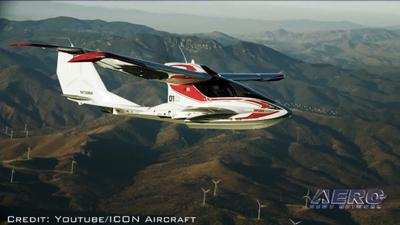Cites Flight Into Canyon At Low Altitude As Contributing Factor
The NTSB has released its probable cause report from a well-publicized accident which occurred May 8th in California involving an Icon A5 amphibious airplane. Two people were fatally injured in the accident.

The board places the responsibility for the accident on the actions of the pilot. According to the report, the commercial pilot departed in the light sport, amphibious airplane during daytime visual meteorological conditions to perform a new employee familiarization flight with the passenger, who the company had recently hired. A witness, who was in a boat on a lake, reported seeing the accident airplane flying about 30 to 50 ft over the water at what appeared to be between 30 to 40 mph. The witness added that, as the airplane passed by his position and entered a nearby cove, which was surrounded by rising terrain on either side and at its end, he heard the engine "rev up and accelerate hard" as the airplane approached the right side of the canyon "in what appeared to be an effort to climb out of" the canyon. Subsequently, the airplane climbed to about 100 ft above the water and entered a left turn as it began to descend before it flew beyond the witness's field of view. The witness stated that he
heard the sound of impact shortly after losing sight of the airplane.
Review of recorded data from two separate recording devices installed in the airplane revealed that, about 15 minutes after departure, the airplane started a descent from 3,700 ft GPS altitude. About 7 minutes later, it had descended to 450 ft GPS altitude and turned to a northerly heading, staying over the water between the shorelines. About 46 seconds later, at a GPS altitude of 450 ft and 54 knots indicated airspeed (KIAS), the airplane entered the cove. About 20 seconds later, engine power was increased, and the airplane began to climb while it turned slightly right before initiating a left turn. The airplane reached a maximum GPS altitude of 506 ft before it began to descend. Shortly after, the airplane impacted terrain at a GPS altitude of 470 ft and 66 KIAS. Postaccident examination of the airframe and engine revealed no evidence of any preexisting mechanical malfunctions that would have precluded normal operation.
It is likely that the pilot mistakenly thought the canyon that he entered was a different canyon that led to the larger, open portion of the lake. Additionally, it is likely that, once the pilot realized there was no exit from the canyon, he attempted to perform a 180° left turn to exit in the direction from which he entered. Based upon performance information outlined in the Pilot's Operating Handbook for the accident airplane, the airplane's altitude above the water's surface and its indicated airspeed, and the ridge line elevations in the area adjacent to the accident site, the airplane would have not been able to climb out of the rising terrain that surrounded the area, which led to his failure to maintain clearance from terrain.
The NTSB determined the probable cause(s) of this accident to be the pilot's failure to maintain clearance from terrain while maneuvering at a low altitude. Contributing to the accident was the pilot's mistaken entry into a canyon surrounded by steep rising terrain while at a low altitude for reasons that could not be determined.
(Image from file. Not accident airplane)
 Airborne 06.30.25: US v ADS-B Misuse, Natl STOL Fire, Volocopter Resumes
Airborne 06.30.25: US v ADS-B Misuse, Natl STOL Fire, Volocopter Resumes NTSB Prelim: Piper PA-23
NTSB Prelim: Piper PA-23 ANN FAQ: Submit a News Story!
ANN FAQ: Submit a News Story! Classic Aero-TV: One Mans Vietnam
Classic Aero-TV: One Mans Vietnam Klyde Morris (06.30.25)
Klyde Morris (06.30.25)


